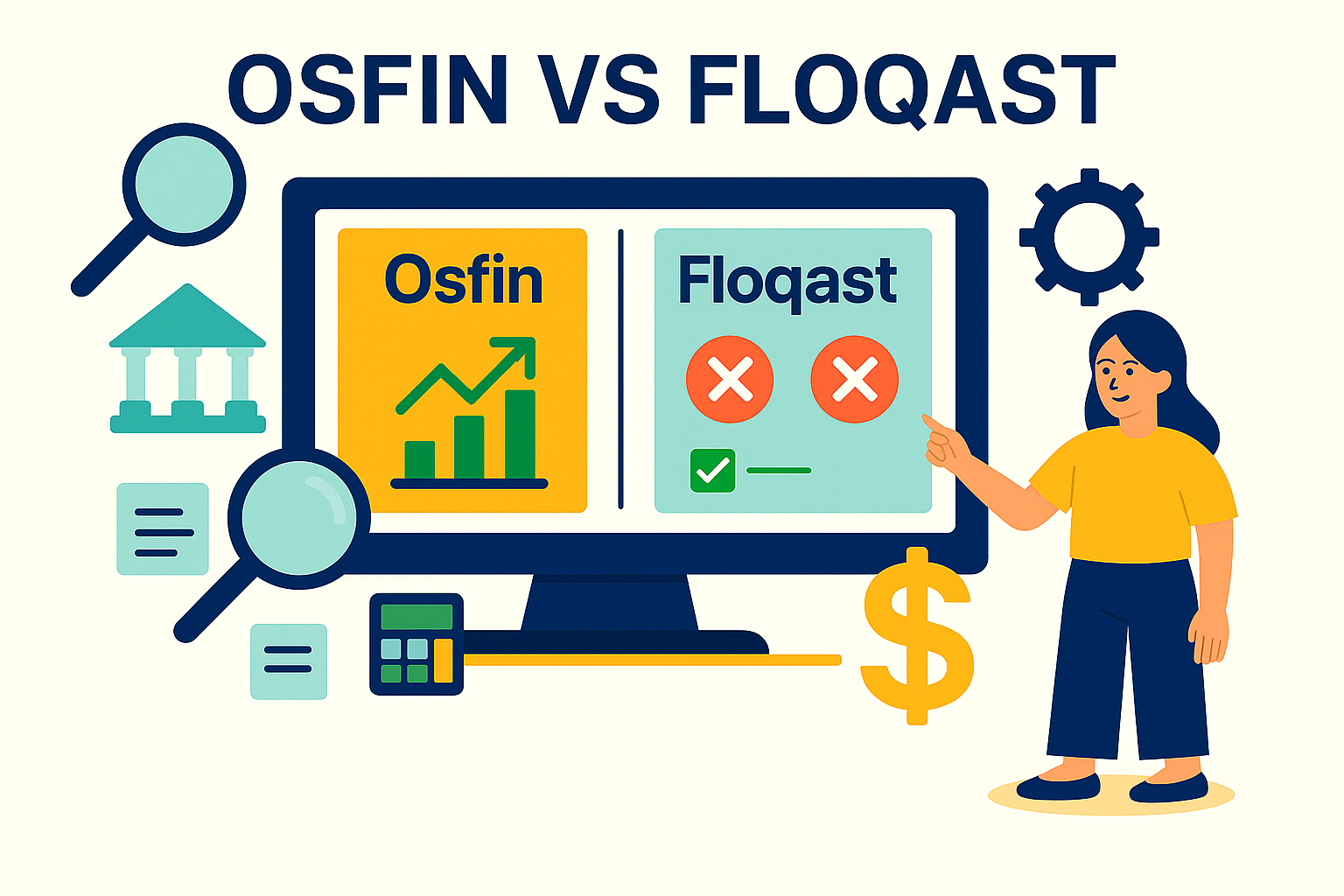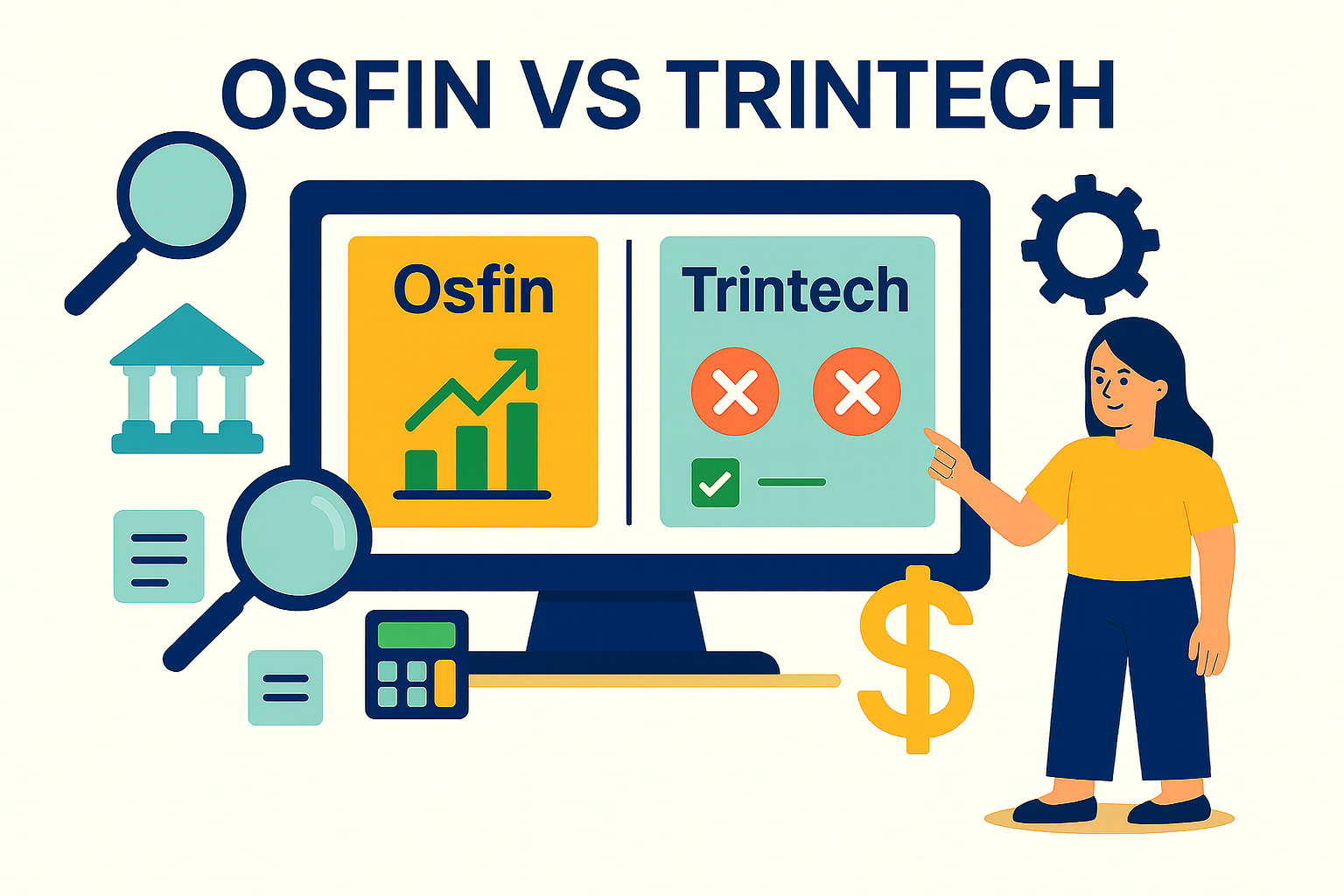Compare Revenue Forecasting Tools: Features, Integrations & Pricing (2025)
Inaccurate revenue predictions often lead to businesses facing costly errors and reworks. Businesses can miss their targets as outdated spreadsheets and complex forecasting tools can delay important financial and operational decisions. In this case, reconciliation too takes a lot of time and hinders the ability to anticipate market shifts or operational demands in real time.
Forecasting tools for finance teams automate revenue projections so your business gains scalable workflows, reduced manual errors, and improved alignment with strategic goals, all while maintaining 100% accuracy and audit readiness.
This article explores essential revenue forecasting tools available in 2025, while outlining their key features, benefits, and ways to select the best fit.
What Are Forecasting Tools for Finance Teams?
Fintechs looking to anticipate revenue opt for forecasting tools to automate the process of understanding the flow of revenue and expense data and modeling possible scenarios so budgeting becomes easy. Leading business forecasting software solutions offer customizable algorithms and predictive dashboards that can easily adapt to growing organizational complexities.
Financial forecasting software free trials and purchased versions tools, both offer accurate predictions and documentation for audit readiness. The right forecasting software transforms planning from reactive to proactive so your businesses align financial expectations with strategic and growth-oriented action plans.
Key Features to Look for in Forecasting Tools
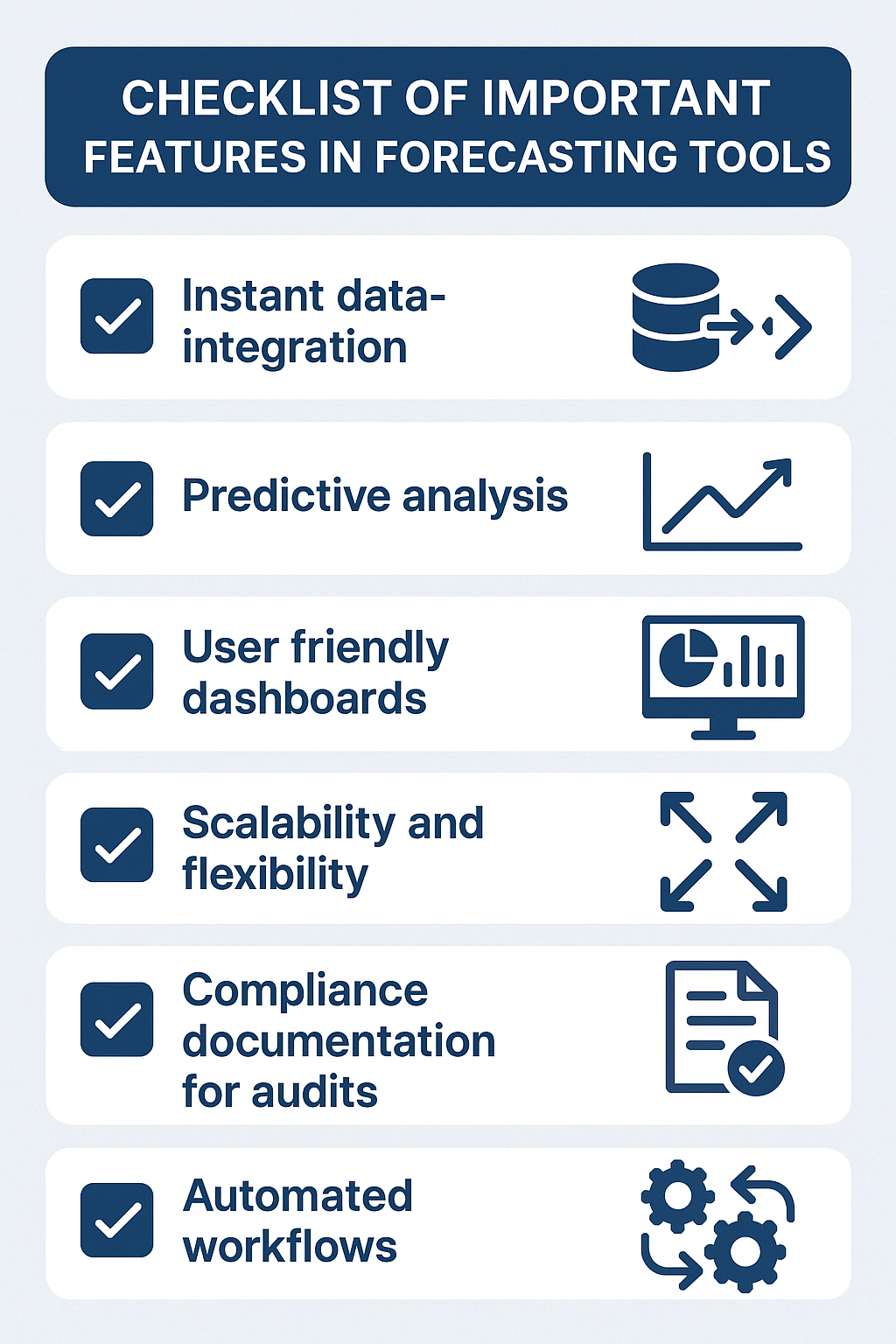
Choosing the right forecasting tools for finance teams involves identifying and opting for capabilities to drive accuracy, speed, and adaptability while making revenue projections for your business. Here are the core features that set the best revenue forecasting tools apart in 2025.
1. Real-Time Data Integration
Seamlessly compiling real-time financial and operational data from multiple sources is a fundamental requirement for forecasting business revenue. When data is simultaneously integrated, it removes delays caused by manual data imports or batch processing for continuous visibility into cash flow and revenue streams.
2. Advanced Predictive Analytics
Customizable algorithms and machine learning capabilities in a business forecasting software allow users to plan out various business scenarios and anticipate future outcomes accurately. This transforms static forecasts into dynamic and data-driven decision frameworks.
3. User-Friendly Dashboards
Intuitive and configurable dashboards depict complex forecasts in the form of clear visual formats for quick interpretation and actionable insights. The best tools for forecasting support drill-downs from high-level views to transaction-level details without any technical barriers.
4. Scalability and Flexibility
Modern forecasting tools software are designed to grow as business complexity grows. This means the platform too will grow to handle increasing volumes of data, multiple entities, and evolving financial models. Efficient platforms also offer configurations for differing industries and regulatory requirements.
5. Audit and Compliance Readiness
Ensuring traceability with 100% accuracy, premium financial forecasting software offer free trials and licensed products to maintain traceability and 100% accuracy while maintaining audit trails. This is essential for financial institutions that must align their forecasts with compliance standards.
6. Automation and Workflow Integration
Viable forecasting software reduces manual errors and intervention by automating data reconciliation, validation, and detecting any mismatches. Seamless integration with ERP, accounting, and planning systems allows for streamlined forecasting workflows.
Benefits of Using Forecasting Tools in Finance
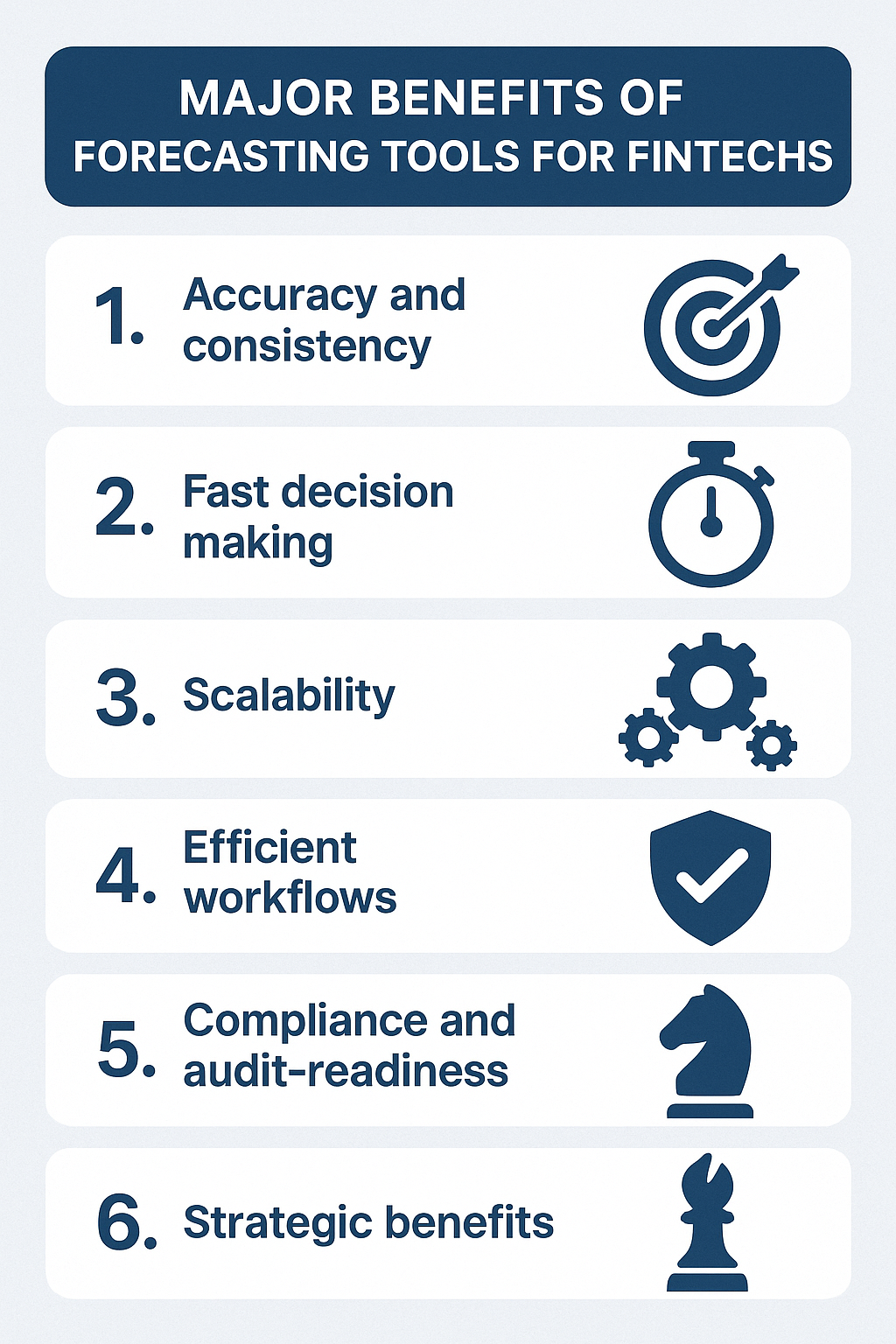
Businesses with the right revenue forecasting tools gain clarity and control over finances for making smarter business decisions that are relevant to real-world complexities. Below are the key benefits that distinguish top-tier forecasting software tools in today’s competitive environment.
1. Enhanced Accuracy and Consistency
A well-chosen business forecasting software delivers precision by reducing manual errors and maintaining consistent predictions across datasets. Such accuracy and reliability helps businesses plan finances confidently while keeping all records audit-ready.
2. Accelerated Decision-Making
With automated data processing and real-time updates allow finance teams to shift focus quickly to respond well to market shifts or unexpected trends. The best forecasting tools software enable instant scenario analysis and budget recalibration without the commonly occurring delays.
3. Scalability Across Complexity
Leading platforms can operate with growing data volumes, multiple business units, and evolving financial models. This scalability ensures that your business's forecasting capabilities remain timely and adaptable.
4. Integrated Workflow Efficiency
Forecasting software tools eliminate data silos and manual reconciliations by syncing seamlessly with existing ERP and accounting systems. Automated workflows reduce unnecessary draining of resources and allow finance professionals to focus on analysis rather than data management.
5. Compliance and Audit Assurance
Top financial forecasting softwares offer licensed solutions with built-in audit trails, complete traceability and document version control. This is critical for financial institutions that operate under strict regulatory environments.
6. Boosted Strategic Alignment
Accurate and timely forecasts enable finance leaders to align financial targets with broader and long-term strategic goals. The best tools for forecasting provide the actionable steps that are needed to drive sustainable growth.
Evaluating Top Free Forecasting Tools for Finance Teams
The right free forecasting tools help in balancing cost-efficiency and functionality in the long run. The following comparison table highlights key attributes of popular tools, in terms of data integration, predictive analysis, scalability, compliance and more.
1. Google Sheets
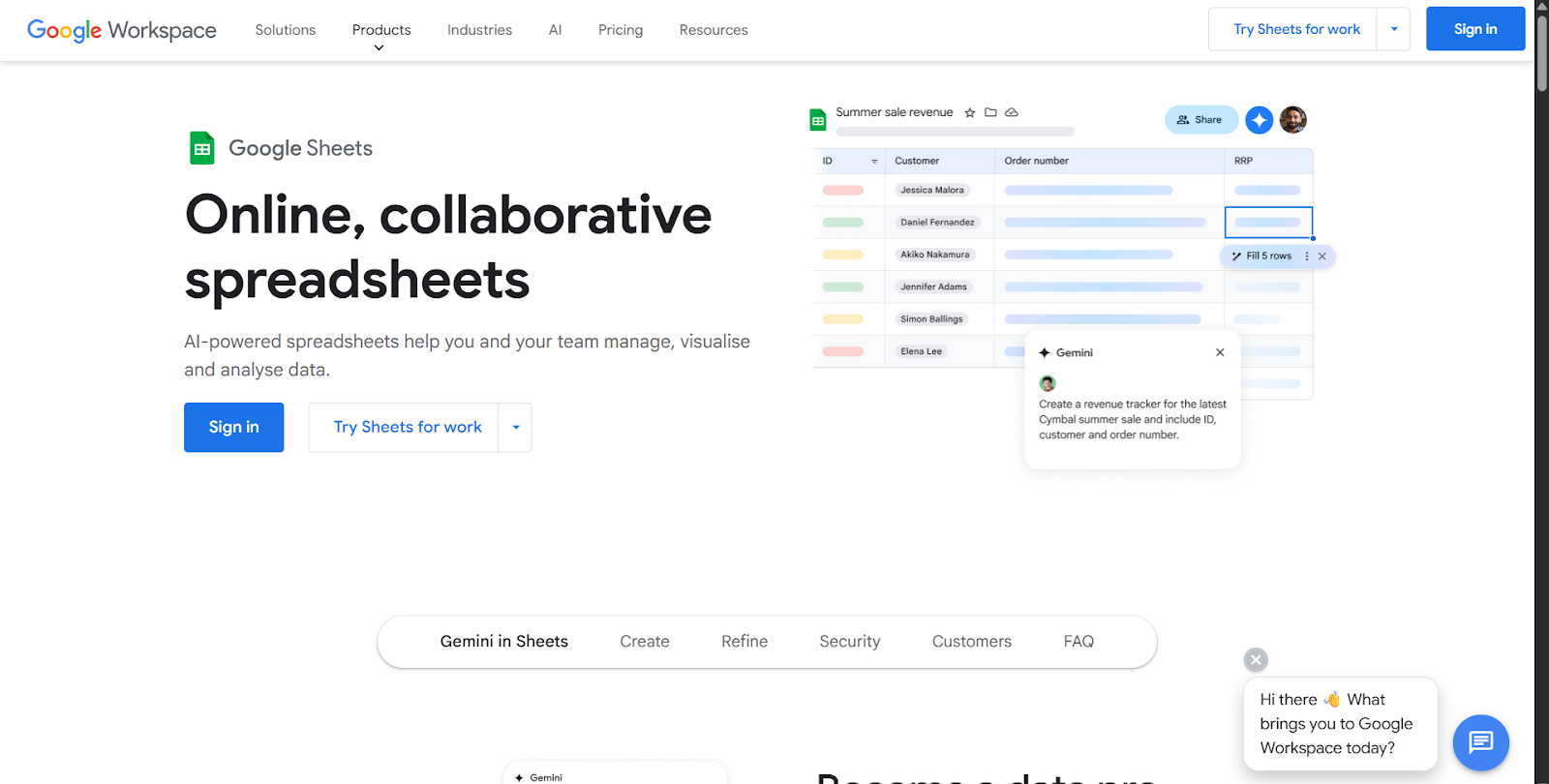
Google Sheets becomes a lightweight forecasting engine when finance teams leverage its real-time collaboration, Google ecosystem connectors, and community-driven add-ons. Custom Apps Script workflows automate data imports from CRM and ERP systems to enable fast scenario testing without any licensing fees.
2. Alteryx
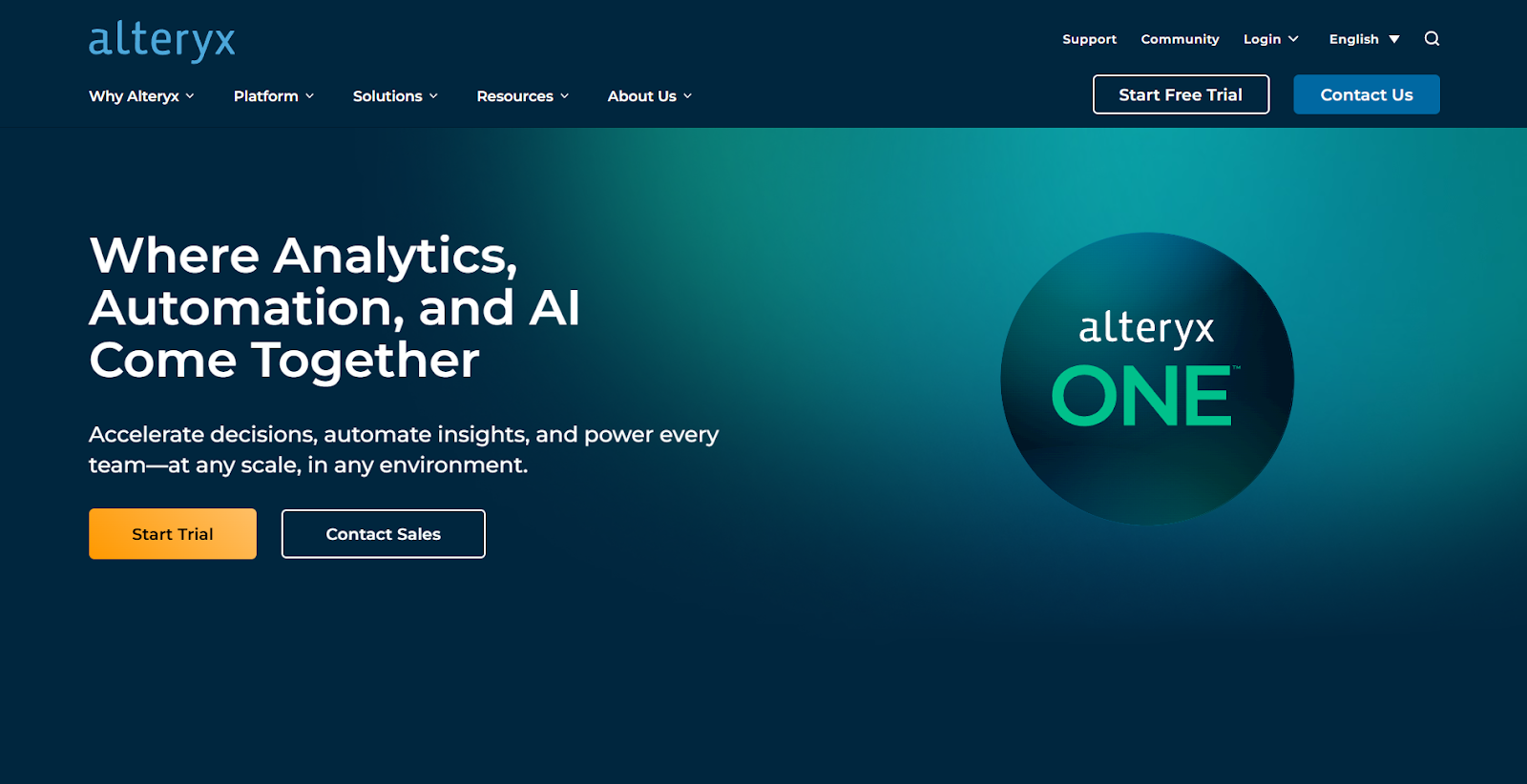
During its free trial, Alteryx unveils powerful drag-and-drop data blending and preparation tools that cleanse transaction records at scale. Analysts can prototype advanced revenue models with minimal IT support while iterating through possible what-if scenarios before upgrading to a paid tier.
3. Finanscapes
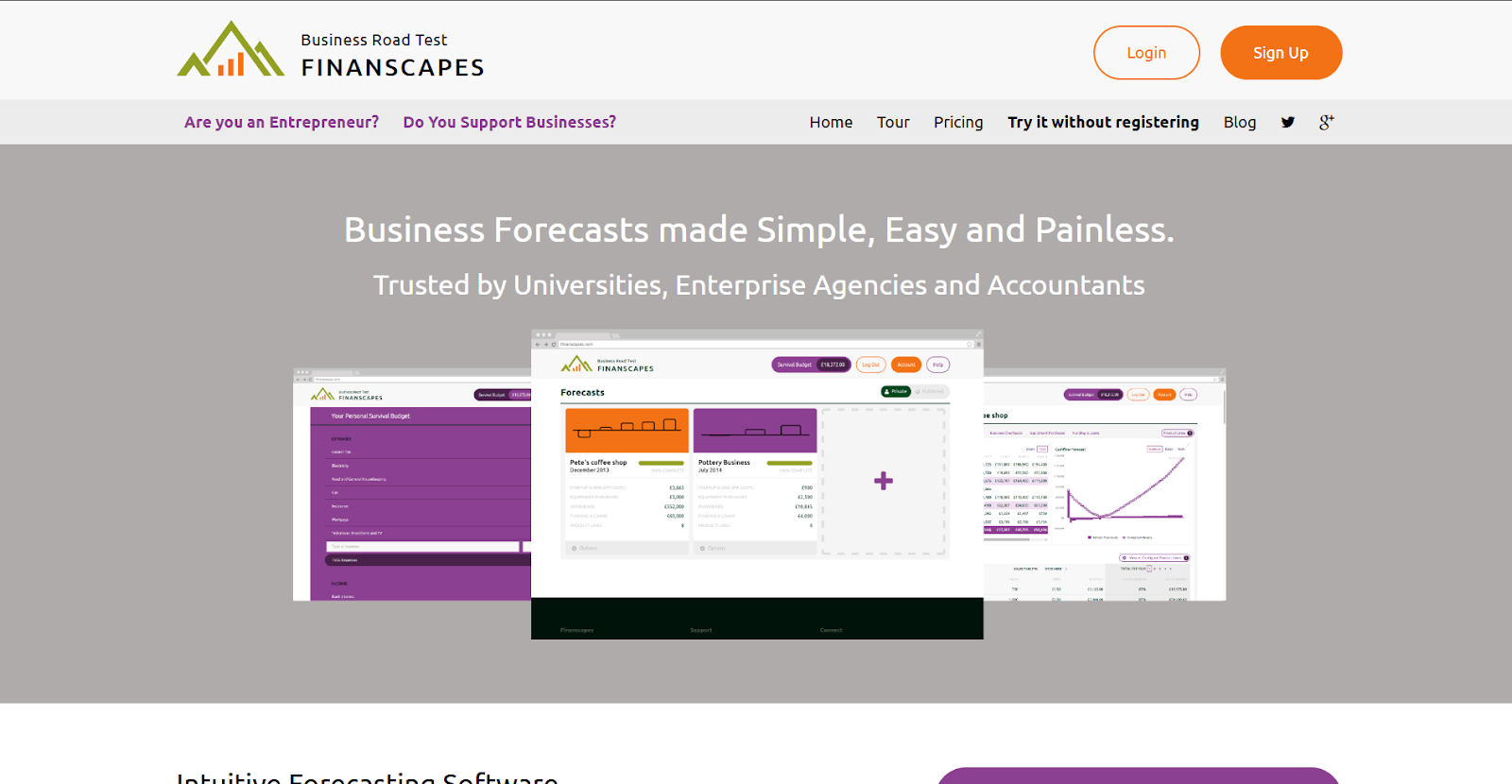
Finanscapes embeds within Excel to centralize disparate financial data into a single interface, complete with connectors to NetSuite, QuickBooks, and bank feeds. Its free tier supports multi-scenario planning and basic analytics so teams can maintain familiar spreadsheet workflows while building a scalable forecasting framework.
4. PlanGuru
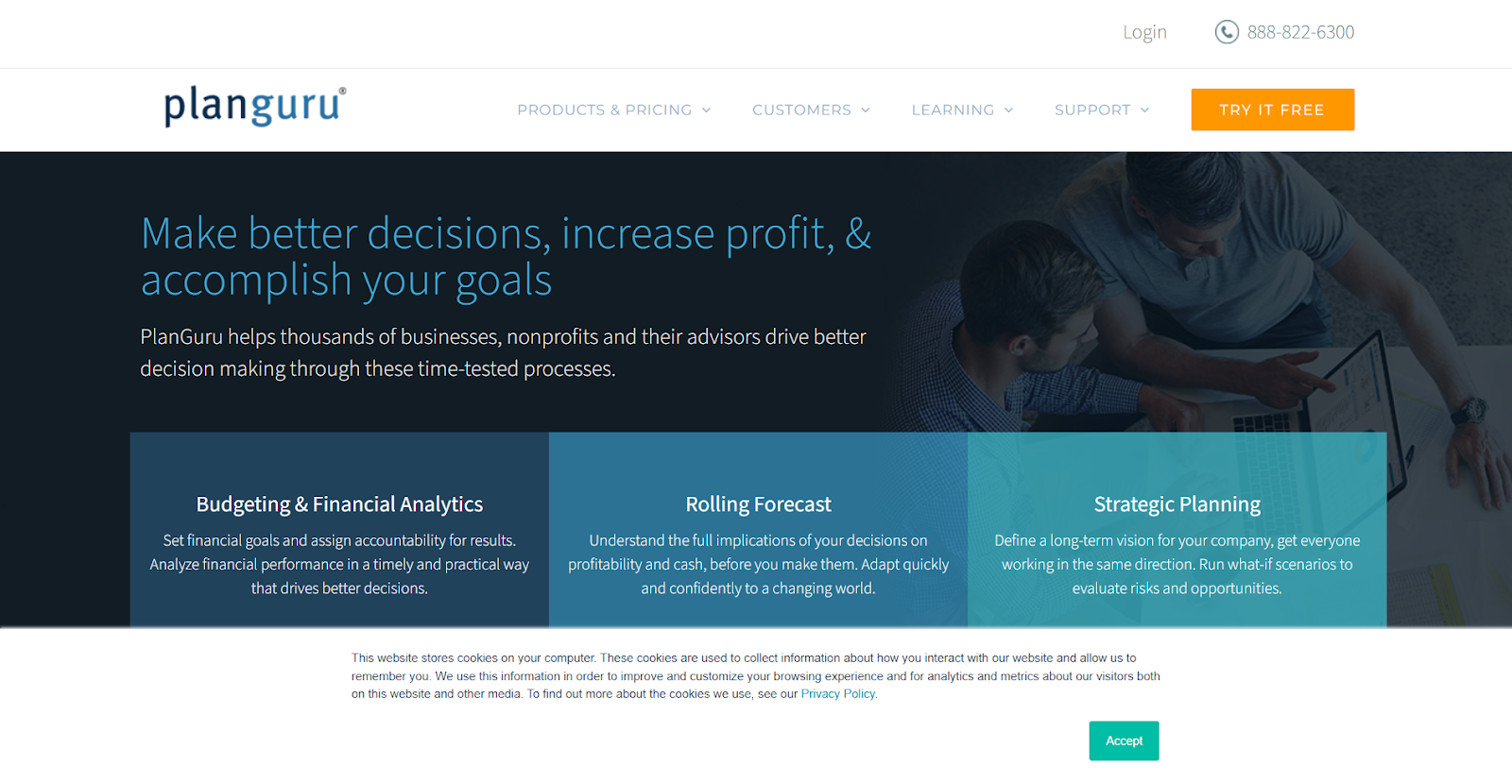
PlanGuru’s trial offers purpose-built budgeting templates and rolling forecast engines to streamline multi-year revenue projections. By integrating robust financial logic into intuitive dashboards, teams can automate variance analysis and move beyond error-prone manual forecasts that lay the groundwork for full-scale business forecasting initiatives.
Top Revenue Forecasting Software for 2025
Leading revenue prediction tools can easily adapt to volatile markets while maintaining the accuracy and compliance standards mandated by banks and financial services. Below, you’ll find detailed information on the best software for forecasting so you can make the most suited choice for your business.
1. Payouts
Payouts offers a streamlined interface that ingests transaction and ERP feeds in real time, enabling finance teams to project revenues from payment rails without manual imports. Its modular architecture scales on demand making it a reliable tool for forecasting cash flows and payment volumes that vary depending on the season.
Learn More
2. Phocas
Phocas combines cross-departmental data consolidation with intuitive drill-down charts, turning complex sales and financial data into actionable revenue trends. Designed for collaborative budgeting, it empowers CFOs to overlay multiple scenarios in seconds and maintain compliance through built-in audit logs.
3. Vena
Vena includes forecasting within the Excel spreadsheets with advanced workflow controls. Its templates and scenario dashboards help finance teams avoid costly reworks and keep forecasts aligned with evolving business drivers.
How to Choose the Right Forecasting Tool for Your Team
When choosing the perfect forecasting tool for finance teams, it is advisable to opt for a user-friendly design to build accurate and scalable forecasts that are ready for audits. Therefore, here's how to look for tools that integrate seamlessly to offer powerful analytics without compromising flexibility or security.
1. Integration Capabilities
Select forecasting software that effortlessly connects to your core systems, be it ERP, CRM, payment gateways, or data warehouses. Native connectors and APIs ensure that all data integrates in real-time without needing to be done manually. This plus-point reduces delays and boosts responsiveness for growing finance teams.
2. Analytics & Scenario Modeling
Businesses must look for platforms that support customizable and predictive algorithms that come with intuitive what-if scenario engines. These features help finance teams so they can test pricing strategies, product launches, or economic shifts in real time to stay ahead of market trends.
3. User Experience & Adoption
Interactive and easy-to-configure dashboards with self-service interfaces are easy to adopt for businesses and fintechs. This supports the finance teams as it enables drill-downs from high-level forecasts to granular transaction detail, all without needing IT or advanced training.
4. Scalability & Performance
Ensure that your tool can process hefty records rapidly while scaling across business units and increasing market and data complexity. Choosing a future-proof and flexible platform infrastructure safeguards performance, even when data volumes increase.
5. Governance, Security & Compliance
Choose a platform that is built for finance-grade security, while offering features like audit trails, version control, role-based access, and compliance with national and international frameworks such as SOC 2, PCI DSS, ISO 27001 and GDPR. Ensuring compliance with them is necessary to fulfill regulatory requirements.
6. Total Cost of Ownership
Evaluate licensing, implementation and support costs thoroughly before actually choosing your business forecasting software. Free tools may be helpful for laying the groundwork for forecasting, but businesses must also consider the long-term return on investment from scalable and automated forecasting software that delivers accuracy, compliance, and streamlined workflows.
Future Trends in Forecasting for Finance Teams
Successful and upcoming platforms have become adaptive engines that deliver precision, speed, and insights that are actionable. Finance leaders now require tools that not only handle mountains of data but empower their teams to anticipate change and confidently seize new opportunities. Therefore, the emerging trends that are advancing business forecasting are as follows.
1. AI-Driven Precision with Machine Learning
Next-generation forecasting softwares have started using artificial intelligence to analyze any recurring patterns to continuously improve their predictions. These intelligent engines learn from previous data and live inputs so finance teams can stress-test scenarios in advance with unmatched accuracy.
2. Seamless Real-Time Forecasting
The monthly forecasting cycle is being replaced by platforms that ingest data continuously from multiple sources. This live updating empowers finance teams to react instantly to market shifts, operational disruptions, or customer trends so financial plans can fully match reality.
3. Personalized Scenario Modeling
Leading forecasting solutions now offer customizable “what-if” engines to consider every aspect such as product, geographic, and customer segments. Finance professionals use this granular approach so they can adapt to forecasts and match the complexity of modern business models and goals.
4. Native Cloud Scalability and Collaboration
Today’s prediction tools scale effortlessly as data volumes and user teams grow as they operate on cloud-native architectures. Simultaneous and shared dashboards help businesses spot and break down silos. This calls in for finance, operations, and strategy teams to work together in real time.
5. Blockchain for Audit Trails
Blockchain integration is emerging as a game changer when it comes to forecasts for businesses. Defined and set ledgers take note of every adjustment and revision, which then enhance the overall transparency and simplify compliance for regulated financial institutions.
6. Workflow Automation and Integration
Automation now covers broader factors such as validation, exception routing, and approval workflows. These capabilities free the finance teams from spending too much time on manual tasks, so they can focus on financial and scaling operations.
How Osfin Enhances Revenue Forecasting for Finance Teams
Osfin enhances the accuracy of your revenue forecasting tools by delivering reconciled and audit-ready data. The records Osfin delivers are verified, traceable and accurate to support forecasting processes for fintechs. The benefits Osfin provides to finance teams are further explained below.
1. Data Ingestion from Multiple File Formats
Osfin’s file-format agnostic platform imports data from over 170+ sources, including ERPs, payment gateways, CRM systems, and core banking platforms. The engine accepts all file formats including Excel, CSV, MT940, PDF without needing manual oversight. The platform applies custom risk tolerance limits while importing to block poor-quality data and flag duplicates to ensure only high-quality, reliable data flows forward.
2. Fast and Logic-Based Reconciliation
After ingestion, Osfin uses advanced logic-based rules to perform many-to-one and one-to-many matching of transactions. The platform also reconciles up to 30 million records in just 15 minutes and can auto-reconcile payment gateway reports with detailed commission, tax, and fee breakdowns.
3. Exception Management
Osfin automatically flags unmatched transactions, assigns a reason to each break and routes it to the right team using its ticketing module. Its live dashboards give fintechs access to reconciliation status, exception queues, and areas of exposure, so teams can resolve issues proactively and maintain forecast workflows.
4. Audit-Reasy Compliance
The platform generates compliance-ready reports that are traceable with complete audit trails for compliance with SOC 2, PCI DSS, ISO 27001, and GDPR standards. All data is secured and reconciled with features like 256-bit SSL encryption, role-based access, and two-factor authentication.
Explore how Osfin.ai’s forecasting capabilities can help you with financial planning and keep your business ahead of the curve.
FAQs on Revenue Forecasting Tools
1. How do forecasting tools handle data anomalies and unexpected market changes?
Forecasting tools use algorithms for mismatch detection to flag any unusual patterns or errors in the data. This proactive alerting approach helps finance teams so they can investigate and adjust forecasts promptly while maintaining accuracy even during market volatility.
2. What role do user permissions play in forecasting software for finance teams?
User permissions help control access to sensitive financial data and forecasting models. Role-based access ensures that only authorized employees and personnel can modify forecasts to boost data security and compliance.
3. How do forecasting tools support multi-department collaboration?
Modern forecasting platforms allow multiple departments to access and contribute to the forecasting process at the same time. This allows for synchronicity across different teams such as finance, sales and operations, ensuring shared insights and coordinated planning.
4. Can forecasting tools incorporate non-financial data inputs?
Yes, advanced forecasting tools allow you to integrate non-financial data like customer behavior, market indicators and supply chain metrics to enrich revenue predictions and provide comprehensive business insights.
